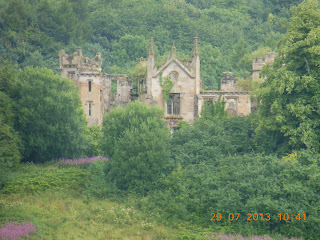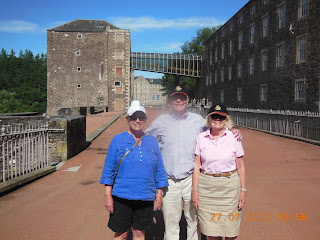I had certainly
felt tired following a pretty gruelling 28km the previous day, and had even had
cramp during the night. Irvine
had also been pretty exhausted, so he decided to walk only for half the day
with me, and visit some of the grand houses in the Borders in the afternoon. So
when John took us back to Harestanes we asked him to pick up Irvine at St Boswells, which we would
comfortably reach by lunchtime.
From the Visitor
Centre at Harestanes it was back the way we had come the previous evening, and
then off through woodland to reach Dere
Street. This was a long stretch through farmland,
conforming with the Roman ideal of being absolutely dead straight. There is no
sign of the stone base that must have been laid originally: there was no way of
knowing whether it was taken over the millennia for local building, or whether
it had simply been covered with soil over the years. The footpath meanders
through a forty-metre wide avenue fenced off from the fields on either side.
 |
| Information board at Lillian's Stone |
Half way along
this stretch we came across Lilliards’s Stone, right at the point where one
switches to the next OS sheet. This celebrates “fair maiden Lilliard” who
fought in a battle against the English. The stone bears an inscription:
Fair maiden Lilliard / lies under this stane
little was her stature / but muckle was her fame
upon the English loons / she laid monie thumps
and when her legs were cuttit off / she fought upon her stumps.
An information
board nearby suggests that the rhyme had originally been associated with an
English knight at an earlier battle, and been taken and adapted by the Scots.
Whatever. It certainly serves to underline the brutality of medieval warfare.
At the time we
thought that the battle of Lilliard’s Edge, which was where we saw the stone,
had probably been one of several minor skirmishes, with relatively small numbers
of combatants and casualties. I have since learned that this was not so: it was
actually the battle of Ancrum Moor, where after sacking all four of the great
Border Abbeys at the behest of Henry VIII, the Earl of Hertford’s army finally
met its match and was roundly defeated. Some 800 English soldiers perished, and
almost as many were taken prisoner.
This border
country was really the focus of 500 years or more of fighting between England and Scotland, and lawlessness when it
wasn’t actually a war. So our thoughts, as an Englishman and a Scot, turned to
current affairs. After all it’ll be time for Scots to vote on potential
separation in just 15 months.
Neither of us
believe that Salmond will win the argument. Irvine hopes that he’s roundly
defeated so that he can’t make any special pleading (“it was raining”) and ask
for a re-run a couple of years later. He also pointed out that Scotland
simply wouldn’t have the resources to handle all the administration that would
be required after independence. And what would happen to all the treaties to
which they are party as a result of being in the UK? With NATO, with the EU, with
others? How would the National Debt be apportioned? What currency would they
use? Irvine
also points out that some pretty heavy international pressure will be against
separation. If Scotland
succeeds, what about Catalonia
and all the other parts of European countries “yearning to be free”?
 |
| Meltoun Bridge over the Tweed |
After turning off Dere Street it was down to the Tweed valley shortly after Maxton. There Irvine left me to make his way to the
Buccleuch Arms hotel (and a welcome sandwich and beer), where he was to be
picked up to go back to Jedburgh for his car. My route then took the pretty
way, following the Tweed around a great bend to reach a point not more than a
quarter mile form where Irvine
had gone to meet his taxi. This is a beautiful stretch of water, with what are
obviously fine pools for salmon. Nobody was fishing, though: the Tweed is, I think, essentially a late river, and in any
case the water was pretty low. In these conditions I would certainly hesitate
to invest the several hundred pounds a day that a good beat on the Tweed costs. I’d want to know there were fresh-run fish.
 |
| Dryburgh Abbey Hotel from across the Tweed |
The point where I
finally left the Tweed was directly opposite
Dryburgh. The Hotel where we’d eaten a couple of days earlier was clearly
visible, but the Abbey was still hidden behind trees.
 |
| The distinctive Eildon Hills from the East |
As with the Pennine Way, St
Cuthbert’s Way never takes the easier options, so instead of a more direct
route to Melrose
it crosses the Eildon Hills. These are three rounded peaks, not particularly
high, but isolated and visible for miles. The path goes inland to the
attractive village
of Bowden, and the climbs
up through woodland to cross the hills by way of the col between the Middle and
North Hills. Then it’s a fairly steep descent into Melrose itself. I arrived half an hour before
the appointed time, but the coffee shop near the Abbey was already closing at
4:30. I don’t begin to understand. This was the tourist season; people were
leaving the Abbey as it closed; surely there would be customers? Or has
enterprise died in the Borders?
Irvine met
me at Melrose, having visited Mellerstain House
and Floors Castle. Mellerstain is the work of
William Adam and his son Robert, and has some of the finest Adam interiors,
which Irvine
had long wished to see. However, he reported that it now seems somewhat run
down, no doubt through lack of money. Irvine
hadn’t had time to go into Floors Castle, but the building itself – Scotland’s largest inhabited castle
– is quite magnificent. It’s one of the principal Roxburghe properties, further
evidence of how the Kers, as former Border reivers, benefited from ennoblement
after the Union.
 |
| The view over Melrose from the Eildon Hills |
We drove back to
our B&B. Irvine reported that the Buccleuch Arms seemed to have a good
restaurant, so (with confirmation from Tripadvisor) that’s where we went for
our last dinner in the Borders. Excellent starters, excellent steaks, and
reasonably priced, so it exceeded expectations.
I was interested
to know what Irvine’s
ambitions now are. It seems that they very much revolve around the schools he
is supporting in Newcastle.
They’re really making a difference, and are improving outcomes significantly.
He supports a secondary academy, divided into four separate units, and more
recently has become involved with three primary schools, so that kids are
helped even before they reach secondary level. There is a rigorous system of
measuring teachers’ performance through added value, and excellent management.
He is a great believer in making sure that kids from hugely disadvantaged
backgrounds aren’t handicapped by starting the day hungry, so they provide
breakfast. For later in the day they provide what he believes is the best
school food in the country. This is supported by his own experience when eating
there.
Irvine had talked with one of his friends, also
a major philanthropist with an interest in schools, about when he could expect
to achieve his objectives. The answer is – never. Once one starts to support a
school there is no limit in time or cash as to what can be done. One of the
issues he is now facing is how to manage his schemes. He has an excellent
former headmaster working for him, but he is much the same age as Irvine, and succession is
likely to become an issue. I suggested that management training for good
teachers might be necessary, which got Irvine
thinking that it might be something he should discuss with Michael Gove as an
area where he could also contribute.
 |
| Irvine and the Welsh Cob in Jedburgh |
On the way back into Jedburgh Irvine spotted a horse rolling on the roadside verge; nearby was a colourful tinker's caravan. We spoke to the chap in it, who had seen us with his (as it turned out) Welsh Cob. They had made their way from Cornwall, had sold a horse at Appleby in Westmoreland, and were going on to Brighton and then to the Camargue. Afterwards I wished we had interrogated him further. Does he have a home, or is the caravan it? How does he finance it? How do you get a caravan and a couple of horses across the Channel? How long has he been doing it? And many more questions that sprung to mind afterwards. We mentioned our discovery to Walter and Jean, and suggested that they might get a local journalist to find out more. I shall be interested to find out if they succeeded.
 |
| Walter, Jean and Irvine |
The following day
we were up early, and drove to Edinburgh airport
where Irvine
had left his Gulfstream 550. My week’s walking was rounded off in style by
being flown in his plane back to Northolt, from which Irvine was to go to
Cliveden and then to Mozart’s Die
Entführung aus dem Serail (Il Seraglio) at the Garsington opera – now at
the Wormsley Estate, which used to be one of my favourite walks when my parents
lived nearby in the Chilterns. He expected to be lobbied to contribute to
Garsington as he does to the Royal Opera, ENO and Glyndebourne.
It had been an
excellent seven days of walking, with splendid company, and except for one
horrible rainy day, pretty reasonable early summer weather.
Cloudy but dry. 13-16C. 24.5km, 534m ascent and 544m
descent. Maximum height 318m in Eildon Hills. Mostly good footpaths, but about
15% on roads.












































